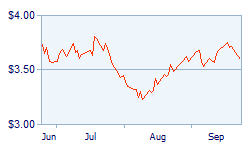As we move out of the second quarter of 2013, generally speaking, we are seeing many encouraging signs that the North American economy continues to stabilize, and increase its grow growth rate. There is more and more positive economic information coming out all time, from continued Fed stimulus in the U.S., continued low interest rates, to housing starts, to reduced jobless rates, to projected GDP growth. The trend is consistent – North America, Canada and Alberta are on the mend, and things are picking up. So, what has this meant for the energy sector?
Natural Gas Markets
Natural Gas markets continue to react to the new global volumes discovered through modern fracking and drilling technologies. As countries around the world discover more and more potential gas reserves under their feet, the issue becomes less about how much potential gas there is, and more about how much gas can actually be extracted and supplied to market. This, combined with an uncharacteristically calm hurricane season, has kept pricing low during this quarter – NYMEX gas prices continue to float around the $3.60/MMBtu mark. As an indicator of what this continued soft NatGas pricing is having on the suppliers, in the U.S., according to Baker Hughes, drilling rigs are up a little bit from mid-June now operating at 386 active, however the rig count is down 109 from this time last year.

NYMEX NatGas Pricing
Here in Alberta, where NatGas still remains largely landlocked, pricing sits event lower, trading as low as $1.74 at the AECO. With Alberta NatGas pricing back near record lows, many wonder when and how the much-needed price correction will come, and local suppliers can return to profitability. In the meantime, production remains relatively flat, despite Alberta exports being down 0.73 BCF/D compared to this time last year, and projections to reach record storage levels. (Source: Gas Alberta)
It is difficult to say exactly when the NatGas market will rebound, but we can assume that it will. Based on current pricing, producers are not incented to continue to supply, and with future plans for increased pipelines, and LNG terminals, eventually, Alberta NatGas will merge with new global markets and pricing will move upwards to come in line. For the immediate time being however, consumers continue to enjoy the low pricing, by either taking a floating position, or by looking to purchase forward now, long-term, in the knowledge that we are seeing historically very low prices that will not likely hold.
http://www.calgaryherald.com/news/politics/Rock+bottom+prices+lead+Alberta+search+natural+markets/8910905/story.html
Turning to Canadian crude oil prices, the ‘Bitumen Bubble’ appears to be behind us. With this, comes a return to healthy market pricing and a return to business as usual in the Alberta oil patch. For this reason, among many, we saw recently improved provincial GDP projections for 2013 at 3.2% and 2014 at 4.1%.
http://www.calgaryherald.com/business/Alberta+economic+leader+despite+devastating+floods/8921778/story.html
Certainly, as the economy continues to pick itself up and dust itself off, energy consumption on the whole continues to grow in North America, Canada and especially here in Alberta. Pricing will have no choice but to respond to this upward pressure.
Power Markets
With the above in mind, key indications are that due to continued tight supply, electricity rates here in Alberta will see ongoing volatility and upward pressure. Unable to meet our current provincial power consumption demands, Alberta remains a net importer of power. As we continue to import from B.C, Saskatchewan and the Northern U.S., we have seen significant daily/monthly rate volatility and price spikes – we have even seen government announcements alerting Albertans to a risk of rolling brownouts and to conserve energy when early September temperatures were higher than expected, http://www.calgaryherald.com/touch/story.html?id=886518. In response, the province is seeking an energy trade partnership with Manitoba Hydro to source additional supply.
As new Alberta generation projects come on-line in the coming years to off-set planned reductions in coal-power, supply should increase, but many of these forms of power generation are considered, ‘alternative’ power, such as biomass, wind, and solar. In all of these cases, the cost of power generation is greater than our existing coal and NatGas generation sources, which currently represent over 80% of our total power supply. From all sides, with accelerating GDP, a move away from coal to more NatGas and alternative power generation technologies, Alberta electricity rates are projected to continue to increase. Couple this with an already planned 30%-40% transmission/delivery rate hike for large commercial/industrial businesses and we will certainly see the average consumer power bill grow significantly, year-over-year for the foreseeable future. In a related and recent move, Capital Power chose to sell 3 of its power plants in the U.S., in favour of re-focusing on the Alberta Market based on projections for continued market growth and business opportunity.
http://www.cbc.ca/news/canada/edmonton/capital-power-to-sell-3-american-plants-focus-on-alberta-1.1319959
While this is the case, forward purchase power options, including block, structured block and load-following term contracts offer effective options for industrial/commercial businesses to better control their electricity operating costs and budget more effectively. In addition to providing improved cost certainty, in many cases, because the forward electricity market is currently trading in backwordation, businesses who were operating off the Default Supply Market, found significant cost reductions, up to 30+%.
Most recently however we have already started to see the futures increase in response to the higher than expected spot market rates, and projected continued supply shortages. Time will tell how long these highly favourable future rates will remain in play, but for the time being, with future rates trading well below the historical 5 year Default Supply average of 8.8cents, and below future expected Default Supply rates, it remains a very good time to look at your electricity options.
